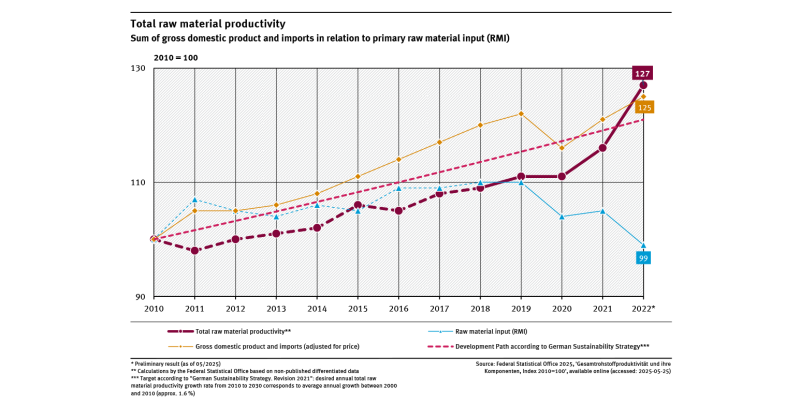Indicator: Total raw material productivity
 Click to enlarge
Click to enlargeSource: Federal Statistical Office of Germany Figure as PDF
 Umweltbundesamt
Umweltbundesamt
 Click to enlarge
Click to enlarge
- The total raw material productivity grew by 27 % between 2010 and 2022.
- According to the German government, an average growth of 1.6 % of total raw material productivity must be achieved between 2010 and 2030.
- After many years in which average growth remained below the target corridor, it has now been achieved for the first time.
- Total raw material productivity is a measure of the efficiency of raw material use and also includes raw materials that were needed to produce imported goods.
Primary raw materials are obtained mainly from mining but also in forestry and agriculture. Some of these economic activities have huge environmental impacts. An aim of environmental policy is therefore to ensure that the national economy uses raw materials as efficiently as possible. In order to measure this development, the indicator 'Total raw material productivity' relates economic activity to the utilisation of raw materials.
However, Germany imports and exports mainly processed goods and finished products. The indicator 'Primary raw material inputs' reflects the extent to which primary raw materials are actually used. It is based on raw material equivalents. It therefore includes the total weight of primary raw materials which were required to produce the goods made in Germany or imported to Germany.
Total raw material productivity in Germany increased by 27% between 2010 and 2022. According to preliminary calculations, a significant increase in total raw material productivity was recorded in 2022. This was due to a significant drop in raw material input (RMI) since 2019. Gross domestic product only fell in 2020, but then started to increase again. It should be noted that 2020 was an exceptional year, as demand and the associated supply chains were affected worldwide due to the COVID-19 pandemic, among other things.
In the new edition of the German Sustainability Strategy of 2016, the German Government has set a new goal for the further growth of raw material productivity: Between 2010 and 2030, the value is expected to increase by an average of roughly 1.6 % per year, which was the average annual increase between 2000 and 2010 (BReg 2016). Growth from 2010 to 2022 exceeded this target corridor for the first time following the notable rise in total raw material productivity in 2022.
In the German Resource Efficiency Programme III (ProgRess III) records a large number of measures for the years from 2020 onwards to increase the productivity of raw materials. As new topics, resource-efficient mobility and the potentials and risks of digitalization for resource efficiency are now being considered in ProgRess III. The German government also developed the National Circular Economy Strategy (NKWS) in 2024, which brings together targets and measures for circular economy and sustainable resource use from all relevant strategies. The indicator “Total Raw Material Productivity” is also included as a central indicator and target in this strategy.
The total raw material productivity results from the ratio of two variables: The numerator is formed from the sum of gross domestic product and the monetary value of German imports. This figure is prepared by the national accounts of the Federal Statistical Office of Germany. The denominator contains the information on the primary raw material input in Germany from production and imports. Both variables are presented as an index (2010=100). The process for determining the indirect imports (‘raw material equivalents’) is described in a research report (in German only). Due to methodological adjustments the time series from 2010 onwards differ from previously published figures. Noticeable changes occur in particular in the raw material group of ores. For more detailed explanations, please refer to the Statistischen Bericht "Rohstoffäquivalente - Berichtszeitraum 2000-2021" (in German only). To calculate the index values on which this indicator is based, the Federal Statistical Office uses more precise data than those published there. The results are published in the table ‘Total raw material productivity and its components, index 2010 = 100’ (in German only).
More detailed information: „Rohstoffproduktivität" (in German only).